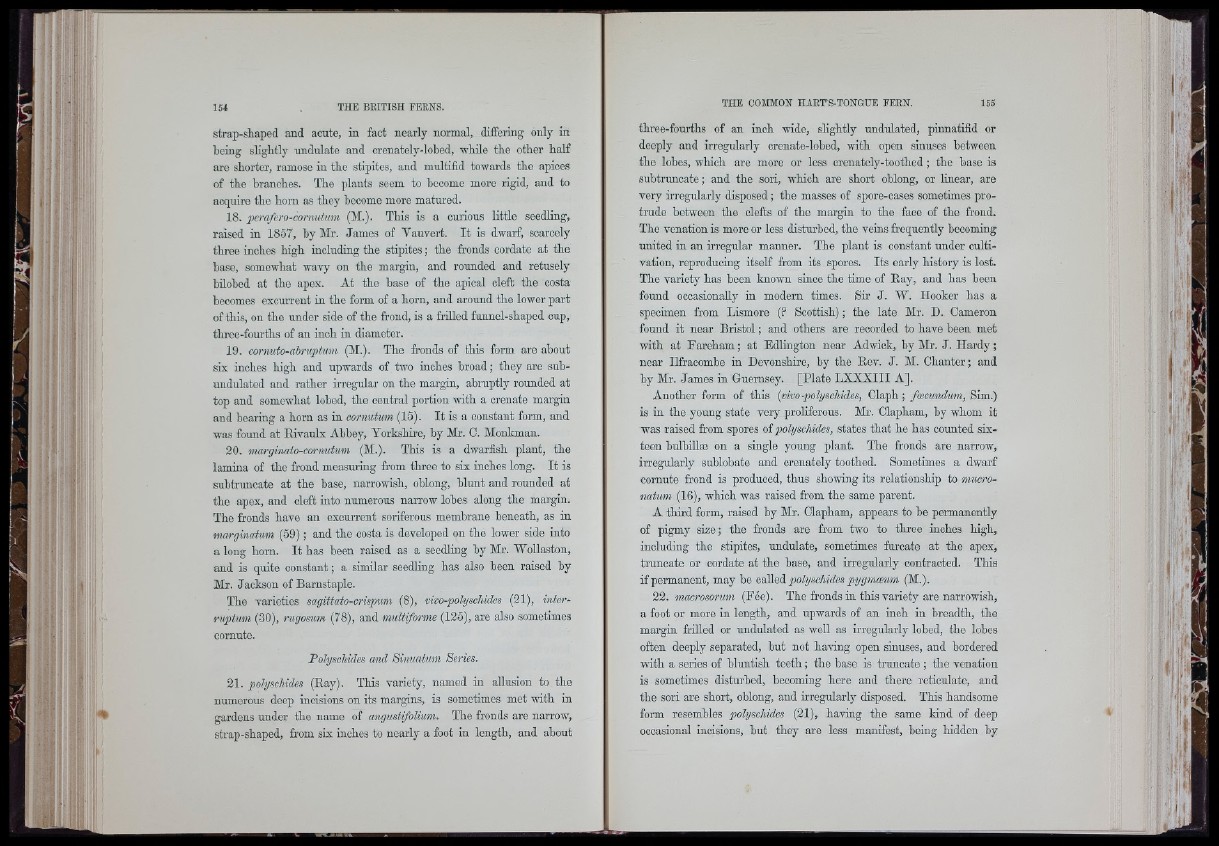
4,
t i
strap-shaped and acute, in fact nearly normal, differing only in
hoing slightly undulate and orenatoly-lobod, while the other half
are shorter, ramose in the stipites, and multifid towards the apices
of the branches. Tho plants seem to become more rigid, and to
acquire the horn as they become moro matured.
18. pcrafero-conmtum (M.). This is a curious little seedling,
raised in 1857, by Mr. James of Vauvert. It is dwarf, scarcely
three inches high including the stipites ; the fronds cordate at the
base, somewhat wavy on the margin, and rounded and retusely
hüobod at tho apex. At the base of the apical cleft the costa
becomes exourrent in the form of a horn, and around the lower part
of this, on the under side of the frond, is a frilled funnel-shaped cup,
three-fourths of an inch in diameter.
19. cormito-ahniptum (M.). The fronds of this form are about
six inches high and upwards of two inches broad ; they are sub-
undulated and rather irregular on the margin, abruptly rounded at
top and somewhat lobed, the central portion with a crenate margin
and bearing a horn as in conudum (16). It is a constant form, and
was found at Eivaulx Abbey, Yorkshire, by Mr. 0. Monkman.
20. marginato-cormdum (M.). This is a dwarfish plant, the
lamina of the frond measuring from threo to six inches long. It is
subtruneate at the base, narrowish, ohlong, blunt and rounded at
the apex, and cleft into numerous narrow lobes along the margin.
Tho fronds have an exourrent soriferous membrane beneath, as in
marginatum (59) ; and the costa is developed on the lower side into
along horn. It has been raised as a seedling by Mr. Wollaston,
and is quite constant ; a similar seedling has also been raised by
Mr. Jackson of Barnstaple.
The varieties sagittato-crispum (8), vivo-polysdiides (21), inter-
ruptum (30), rugostim (78), and multiforme (125), are also sometimes
cornute.
Polyschides and Sinuatum Series.
21. polyschides (Eay). This variety, named in allusion to the
numerous deep incisions on its margins, is sometimes met with in
gardens under the name of angustifolium. The fronds are narrow,
strap-shaped, from six inches to nearly a foot in length, and about
three-fourths of an inch wide, slightly undulated, pinnatifid or
deeply and irregularly cronate-lobed, with open sinuses between
the lobes, which aro more or loss crenately-toothed ; the base is
subtruneate; and the sori, which aro short oblong, or linear, are
very irregularly disposed ; the masses of spore-cases sometimes protrude
between the clefts of the margin to the face of the frond.
The venation is more or less disturbed, the veins frequently becoming
united in an irregular manner. The plant is constant under cultivation,
reproducing itself from its spores. Its early history is lost.
The variety has been knovm since the time of Eay, and has been
found occasionally in modern times. Sir J. W. Hooker has a
specimen from Lismoro (? Scottish) ; the late Mr. D. Cameron
found it near Bristol ; and others are recorded to have been met
with at Fareham; at Edlington near Ad wick, by Mr. J. Hardy;
near Ilfracombe in Devonshire, by the Eev. J. M. Chanter; and
by Mr. James in Guernsey. [Plate LXXXIII A].
Another form of this {woo-polyschides, Claph; foeeundum, Sim.)
is in the young state very proliferous. Mr. Clapham, by whom it
was raised from spores oi polyschides, states that ho has counted sixteen
bulbillæ on a single young plant. The fronds are narrow,
irregularly sublobate and crenately toothed. Sometimes a dwarf
cornute frond is produced, thus showing its relationship to mucronatum
(16), which was raised from the same parent.
A third form, raised by Mr. Clapham, appears to be permanently
of pigmy size; the fronds are from two to three inches high,
including the stipites, undulate, sometimes furcate at the apex,
truncate or cordate at the base, and irregularly contracted. This
if permanent, may be oaAoà. polysohides pygmceum (M.).
22. macrosorum (Fee). The fronds in this variety are narrowish,
a foot or more in length, and upwards of an inch in breadth, the
margin frilled or undulated as well as irregularly lobed, the lobes
often deeply separated, hut not having open sinuses, and bordered
with a series of bluntish teeth; the base is truncate ; the venation
is sometimes disturbed, beooming here and there reticulate, and
the sori are short, oblong, and irregularly disposed. This handsome
form resembles polyschides (21), having the same kind of deep
occasional incisions, but they are less manifest, being hidden by
” I'l
I
iiil
i
*
(
, 1!1
: ri-rl
(!